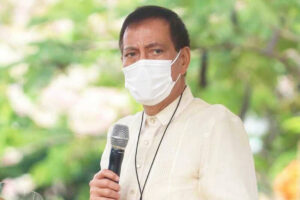By Kyle Aristophere T. Atienza, Reporter
PEOPLE in Cebu City in central Philippines need not wear a face mask except inside hospitals, according to a copy of an order issued by its mayor posted on Facebook.
Lifting the face mask requirement is in line with efforts to open the city, which is home to one of the country’s most beautiful white beaches, to more tourists, Cebu City Mayor Michael L. Rama told ABS-CBN Teleradyo on Wednesday.
“We respect the mandate of local governments over their own jurisdictions,” Press Secretary Trixie Cruz-Angeles told a news briefing. “The president has no reaction to this as of yet.”
Face masks will be mandatory inside hospitals, clinics and other diagnostic centers, Mr. Rama said. “Those are the areas where we can’t tell people not to wear face masks because these are the areas where infections are brewing,” he said in Filipino.
Cebuanos who wish to continue wearing face masks are free to do so.
Face masks are meant for “self-preservation and protection,” and should be worn as part of a “shared responsibility and mutual respect,” according to a copy of the order.
Local businesses could still set their own rules.
“In so doing, all establishments, businesses and entities are hereby mandated a reasonable policy for the purpose and to implement the same in line with self-regulation.”
“The situation worldwide is indicative that the lethal effect of the pandemic is already wearing off and that vaccination has been proven to be an effective means in containing the spread and the impact of COVID-19,” according to the order.
Under the order, immunocompromised people and those who are sick or who have flu-like symptoms must wear face masks outdoors. They should stay home as much as possible.
The National Government’s Inter-Agency Task Force for the Management of Emerging Infectious Diseases still requires the use of face masks.
Mr. Rama’s order came two months after the government of ex-President Rodrigo R. Duterte rejected a plan by Cebu Governor Gwendolyn F. Garcia, an ally of President Ferdinand R. Marcos, Jr., to make face masks outdoors optional.
The National Government at that time said it would not hesitate to charge people, including those in Cebu province, who violate health protocols amid a coronavirus pandemic.
Mr. Rama said the government should “move forward” and adopt a pragmatic view in the fight against the pandemic.
“We were never consulted about this,” Health officer-in-charge Maria Rosario S. Vergeire told a news briefing. “A city within a country cannot act on its own. It can’t be an island.”
She said the case is under the jurisdiction of the Department of Interior and Local Government, the agency responsible for enforcing the National Government’s policies in local governments.
“We have porous borders,” she said. “People travel through different areas of the country. If we are preventing infections in all areas of the country with one area not implementing the safeguards, the risk of infection will be higher in this area.”
Ms. Vergeire said the Philippines should not be compared with more lenient countries because the Southeast Asian nation’s healthcare system is different.
Cebu City, a key economic hub that houses call centers, was among the top 15 cities in the Philippines with the most coronavirus infections as of Aug. 30, having logged 43 infections, according to the OCTA Research Group.
Meanwhile, Ms. Vergeire said severe and critical coronavirus admissions nationwide remained fewer than 1,000 as of Aug. 29.
Mindanao in the country’s south “continues to show a slow uptick in cases,” while infections in the Visayas in central Philippines were on a plateau.
The government had fully vaccinated more than 72 million Filipinos as of Aug. 30, Ms. Vergeire said, with 18 million having received their first booster shot and more than 2.2 million their second booster.
The daily average of coronavirus infections in Manila, the capital and nearby cities has declined by 19%, OCTA fellow Fredegusto P. David tweeted on Tuesday.
The daily average had fallen to 862 cases in the week ending Aug. 29 from 1,062 a week earlier. The virus reproduction number fell to 0.95 on Aug. 26 from 0.99 on Aug. 19, he said.
A reproduction number of less than one shows decreasing infections.
The current average daily attack rate in the region was 5.98 per 100,000, which is considered low, Mr. David said.
The positivity rate in the capital region had also fallen to 12.7% as of Aug. 25 from 14.6% a week earlier.
The healthcare use rate for COVID-19 in the region remained low at 33.3%, while intensive care unit occupancy was 25.8%, he added.
Mr. David at the weekend said daily coronavirus infections in the Philippines could fall to fewer than 1,000 by mid-September.

